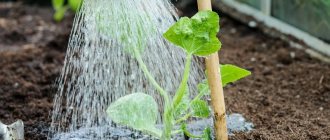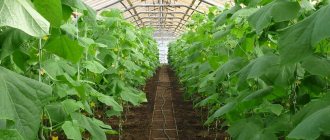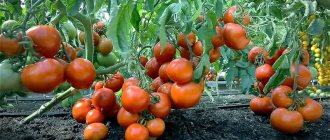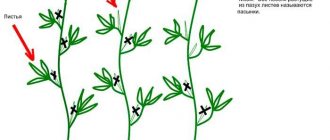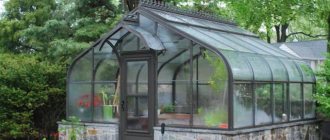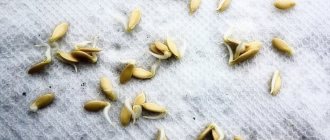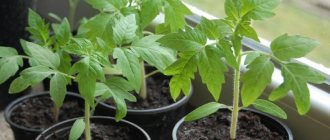Should you plant cucumbers and tomatoes together?
Experienced gardeners believe that growing cucumbers and tomatoes in the same greenhouse is not the best option to reap a large harvest.
The fact is that tomatoes and cucumbers are completely different crops with distinctive needs. The differences are in the need for lighting and humidity levels.
Planting cucumbers and tomatoes together can lead to a problematic situation. Summer residents strive to meet the needs of each crop, but this leads to a decrease in yield.
Increasing the level of humidity in the greenhouse slows down the growth of tomatoes and reduces their immunity, increasing the risk of late blight affecting tomatoes. The seedlings' pollen becomes damp and the inflorescences stop pollinating. As a result, new ovaries do not appear on plants.
If, on the contrary, you create comfortable conditions for tomatoes, this will reduce the yield of cucumbers.
Low air humidity, irregular watering, and ventilation of the greenhouse can slow down the growth of vines. Under such unfavorable conditions, the plant may die.
Comfortable conditions:
- Tomatoes : low air humidity, infrequent watering, frequent ventilation and drafts, application of fertilizers containing phosphorus and potassium.
- For cucumbers : air humidity above 85%, frequent watering, air temperature at least + 22 degrees, application of fertilizers containing nitrogen.
How to find a middle ground if it is not possible to grow two different vegetable crops separately? Tomatoes and cucumbers can still grow together in the same greenhouse. However, to do this, several conditions must be met.
It is important to understand! It is necessary to take into account the characteristics of each culture. What atmosphere in a greenhouse is optimal for the growth of both tomatoes and cucumbers.
Conditions for growing crops
Techniques for growing cucumbers
In a polycarbonate greenhouse:
- Pour drainage from stones and expanded clay. Drainage is necessary to ensure that excess water does not linger.
- To create soil in a greenhouse, you need to use peat and sawdust in a ratio of 10:2. Next, 20 grams of superphosphate and 10 grams of potassium sulfate and nitrate are added to 10 kg of the mixture.
- After two weeks, this mixture must be moistened with water. Next, the seeds are soaked for about 12 hours.
- Seeds need to be planted in holes about 1 cm deep. If the greenhouse is heated and grown in winter, then the seeds do not require germination. Under favorable conditions, the first shoots will appear after a week.
- In a polycarbonate greenhouse, you need to follow the watering regime. It is worth abandoning frequent irrigation of the beds. If these nuances are observed, the plants will develop inflorescences, and, therefore, you should expect a good harvest.
- After the fruits appear, watering must be increased.
Tomato growing technique
For tomatoes, it is necessary to create completely opposite conditions. The lack of a ventilation system and high humidity will lead to late blight. Brown spotting and gray rot appear on plants. Such diseases are dangerous for seedlings.
Tomatoes are rarely watered, as they do not tolerate high humidity. The ideal frequency of soil moistening is once a week. It is important to follow proper watering techniques. Water should fall under the root, and not on the leaves and stems of the plant. This is necessary so that evaporation does not occur, and the water goes directly into the ground.
Tomatoes cannot tolerate heat. If the air temperature exceeds +25 degrees, then the fruits stop developing and ripening. It is for this reason that during the day the greenhouse must be opened, or an artificial draft must be created using vents.
Tomatoes do not require nitrogen-based fertilizers. On the contrary, you should give preference to fertilizers that contain phosphorus and potassium.
Watch the video! How to grow cucumbers and tomatoes in one greenhouse
How to prepare a polycarbonate greenhouse for growing cucumbers and tomatoes in one greenhouse
It is best to maintain conditions for growing vegetables when living together using a hydrometer and thermometer.
A hydrometer is a godsend for such cases. It controls the amount of water without overloading the soil and giving excess moisture to the desired crop. In addition, in the cucumber part of the greenhouse you can place containers with water (barrels) for evaporation.
ATTENTION! Add hydrogel granules to each hole with cucumbers (about half a glass per planting hole).
The best varieties for growing together
In order to grow cucumbers and tomatoes together in a greenhouse, you need to choose the seed material wisely.
It is worth paying attention to the following tomato varieties that are resistant to high levels of humidity and late blight:
- Dwarf;
- New Year;
- Oak;
- Lyubasha;
- Union 8;
- Lark;
- Dubrava;
- Blizzard.
These varieties are hybrids and were specially bred by experienced agronomists. The tomato varieties presented above have strong immunity and are resistant to diseases to which tomatoes are susceptible if there is high air humidity in the greenhouse.
Of course, choosing this type of hybrid crop does not completely minimize the occurrence of problems during joint cultivation. It is worth understanding that choosing only a special variety of tomatoes to obtain a good harvest is not enough; it is important to comply with other conditions.
You should also be responsible when choosing cold-resistant varieties of cucumbers.
If the temperature in the greenhouse does not meet the stated standards, this leads to an increased risk of developing diseases in cucumbers.
The most famous diseases among such a capricious crop are considered to be: powdery mildew, anthracosis and bacteriosis.
Important! Diseases to which cucumbers are susceptible can be transmitted to tomato crops. And this in turn can lead to loss of crops such as cucumbers and tomatoes.
Well-known agronomists have been able to develop many varieties of cucumbers that are disease-resistant and suitable for growing in open ground conditions:
- Masha;
- Benefit;
- Herman F1;
- Tom Thumb;
- Sister Alyonushka.
- Goosebumps;
- Baby Crane;
- Natalie.
By choosing one of the varieties presented above that are resistant to cold and disease, you don’t have to worry about creating special specific microclimate conditions. Such hybrid varieties tolerate ventilation and drafts, which are important for pollination of tomatoes.
How to plant cucumber and tomato seedlings in one greenhouse
Landing:
- seedlings become resistant to diseases;
- Plant cucumbers at a temperature of 10 degrees outside, tomatoes - from 8;
- seedlings are moved from the container into holes slightly deeper than the seedling itself;
- when seating, use the above seating options, the most successful is chess;
- Sprinkle the seedlings with a solution that prevents root rot.
Combination conditions
Professionals highlight special conditions for a favorable relationship between tomatoes and cucumbers:
- Cucumber vines should not create a shadow for tomatoes;
- The ideal place for growing tomatoes is at the entrance to the greenhouse. It is there that ventilation is much more intense, which in turn reduces the level of humidity and the risk of disease is less;
- It is worth paying attention to varieties that are resistant to late blight;
- It is important not to forget about additional pollination. To do this, you need to lightly shake the flowering plants;
- Cucumbers should be planted at the end of the greenhouse. It is there that there are no drafts that lead to a decrease in humidity levels.
Option No. 1 - Film separation
It is worth starting by separating the beds from each other using film. The film must be stretched from the ground to the roof of the greenhouse. This method will help create a special microclimate for each crop. The only condition is that it is necessary to take into account that a ventilation system is provided in the part of the greenhouse where the tomatoes grow. The entrance to the greenhouse zones should be separate at each end. In addition to the air barrier, the soil must also be protected. It is important to leave space between the beds of cucumbers and tomatoes. If it suddenly turns out that the beds of tomatoes and cucumbers are too close, then you should use a metal sheet for a fence. This will ensure that when you water the cucumbers abundantly, you will not create unfavorable conditions for the tomatoes.
Option number 2 - Separate landing
There is an option without using film. To use this method, you need to correctly delimit the beds with cucumbers, peppers and tomatoes.
The ideal option would be a competent division of the territory:
- Pepper should highlight the southern side of the greenhouse. This is due to the fact that such a culture is heat-loving;
- Tomato bushes will grow favorably in the center of the greenhouse, as this part is well ventilated. In addition, places near doors and windows may be suitable;
- Cucumbers should be planted from the north, since moisture evaporates from the plant much more slowly. Corners of the greenhouse protected from drafts are good for growing cucumbers.
Tips from Mister Summer Resident
Some advice from our portal https://mrdachnik.com. The practice of horticulture and plant growing shows that to increase the yield of crops one should:
- ensure that the daily range of air temperatures is less than +5 degrees;
- Orient the greenhouse from north to south, while:
- plant cucumbers on the north side;
- allocate the southern part to tomatoes;
- choose self-pollinating varieties whose flowering period does not coincide;
- During the day, during flowering, shake the plants to promote self-pollination.
Soil preparation and fertilizing
Humus, peat, sawdust, sand must be enriched with a teaspoon of sodium nitrate or urea, and also add 1 tablespoon of potassium and magnesium sulfate, add 3 tablespoons of double superphosphate and 500 grams of wood ash. Next, the fertilizer is scattered over the selected area and the soil is dug up.
Advice! Cucumbers should be fed with saltpeter every ten days in a proportion of 20 grams per bucket of water.
Tomatoes also need feeding every ten days:
- Option 1: dissolve 0.5 liters of liquid mullein + a tablespoon of nitrophoska in 10 liters of water. Each bush requires approximately 1 liter of solution;
- Option 2: dissolve a teaspoon of potassium sulfate in 10 liters of water, as well as a tablespoon of complete fertilizer (fertilize at a ratio of 5 liters per square meter);
- Option 3: in 10 liters of water you need to dissolve a couple of tablespoons of wood ash and a tablespoon of superphosphate (fertilize in a ratio of 6 liters per square meter).
Plants on which tomatoes have already formed must be fertilized with a solution of two tablespoons of superphosphate and one spoon of liquid sodium humate (5 l/sq. m). This type of fertilizer will speed up the ripening of fruits.
Caring for joint crops
Cucumber care
Cucumbers are moisture-loving plants that require abundant and frequent irrigation with warm water. Settled water is ideal for irrigation. It is recommended to use a foliar spray. The optimal humidity in a greenhouse is 85%. If these rules are followed, the yield of cucumbers will be high.
For uniform plant growth and the appearance of ovaries, the temperature should be at least 22 and not exceed 28 degrees. Cucumbers do not tolerate ventilation and natural drafts. Do not forget about regular feeding of seedlings.
Until the cucumber fruits appear, water the seedlings frequently, but not abundantly. As a result, female flowers will form, which will allow you to harvest a good harvest. After the fruits appear, it is necessary to increase watering.
Tomato care
Tomatoes need to be grown in polycarbonate structures.
- The size of a proper bed should be 90 cm wide and 40 cm high. It is ideal to leave a passage between seedlings of approximately 60 cm. A passage between bushes must be required for comfortable growth and ripening of fruits.
- Seedlings whose height does not exceed 30 cm should be placed vertically in the ground.
- Add soil to the hole two weeks after the seedlings have taken root.
- For the first two weeks, you should refrain from excessive watering.
- After the stem is stretched, it must be tied to a trellis. The most optimal is considered to be an ovary of seven racemes with inflorescences. The resulting excess stepsons need to be trimmed.
Watch the video! How to water tomatoes and cucumbers in a greenhouse
Hydrogel - water substitute
Hydrogel is a salvation for many lovers of growing tomatoes and cucumbers together. This type of adsorbent ideally solves the problem of waterlogging of air and soil. Hydrogel crystals almost instantly absorb excess water during irrigation. And they pass it on to the roots of moisture-loving seedlings.
Since the hydrogel absorbs water, when watering, intense evaporation of moisture does not occur into the air, and, therefore, the humidity in the greenhouse does not increase. The adsorbent does not lead to a decrease in the level of immunity in tomatoes, but rather enriches cucumbers with liquid. Thus, it is convenient for two crops to grow side by side at the same time.
How to mark hydrogel? When planting cucumber seedlings, 0.5 cups of hydrogel is added to the hole, then it is watered abundantly and the plant needs to be buried.
The hydrogel is ideal not only for absorbing water, but also mineral fertilizers dissolved in them. If you soak the granules in a fertilizer solution before the first use, you won’t have to worry about plant nutrition for a long time.
Mulch to retain moisture
If it turns out that cucumbers are already planted in a greenhouse without hydrogel, then it is recommended to use mulching. This method will help retain moisture at the roots of the plant and the evaporation process will be reduced.
Rules for using mulch:
- Prepare grass or weed clippings.
- After the cucumber seedlings appear, cover the soil around the seedlings with a layer of mulch (about 10 centimeters).
- Constantly add a layer of mulch as it settles.
Mulching will reduce the amount of watering. In addition, a layer of mulch generates heat, which cucumbers love so much. Moisture evaporation will occur under the mulch. The bottom layer of mulch, when gradually decomposed, releases heat and nutritious organic fertilizers, which are necessary for the growth of vegetables. .
The whole secret is in the origins!
Did you know that every vegetable we love has a wild ancestor? And that real corn was no larger than an ear of corn? But where and how the ancestor of a cultivated plant grew depends on whether it will bear fruit today. And even the painstaking work of modern geneticists trying to cross a tomato with a lizard can only slightly change such properties as its love for warmth and dry air. So let's look at everything in more detail.
The homeland of the cucumber is the tropics and subtropics of India and China. Its wild ancestor can still be found in local forests, where it twines around trees like vines. And, mind you, only in humid areas where there is water nearby!
And in Europe, this vegetable appeared thanks to the Greek conquerors, who called the find “unripe,” which sounds like “auguros” in Greek. When the cucumber entered the gardens of Rus', its local residents quickly called it their “national dish.” Travelers from the West were especially amazed when they saw how cucumbers grew happily in the northern regions, and no worse than in their homeland.
But tomatoes were brought to Europe by the Spaniards. And not because the tomatoes seemed tasty - they were just cute and they decided to grow them decoratively, like “apples of love.” And only in the 19th century, when tomatoes reached Russia and peasants immediately appreciated their nutritional value, these “apples” began to be grown for the table. And the very first tomato was discovered by an Italian monk, Giacomo Tiramisunelli. And do you know where? On dry mountain slopes! Pay close attention to this fact.

